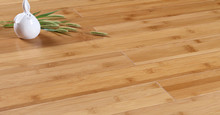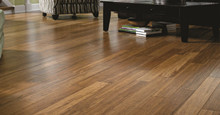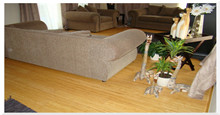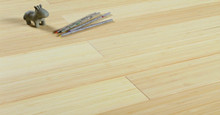Bamboo has gained immense popularity as a decking material, celebrated for its sustainability and aesthetic appeal. Among the various processes that enhance its properties, carbonization stands out as a transformative technique that significantly improves both the color and strength of bamboo decking. As a bamboo decking factory technologist, I have witnessed the profound effects of carbonization, which not only elevates the material’s visual allure but also enhances its structural integrity, making it an ideal choice for outdoor applications.
Understanding Carbonization
Carbonization is a heat treatment process that involves heating bamboo to high temperatures, typically ranging from 180°C to 220°C (356°F to 428°F), in a controlled environment devoid of oxygen. This process alters the chemical structure of the bamboo, leading to several beneficial changes that enhance its performance.
Key Steps in the Carbonization Process:
Heating: Bamboo is subjected to elevated temperatures, which effectively removes moisture and reduces the natural sugars present in the material.
Chemical Transformation: The heat causes a transformation in the bamboo’s lignin and cellulose, resulting in a denser and more robust material. This change not only improves strength but also alters the color.
Color Development: The carbonization process leads to a rich, warm hue in the bamboo, ranging from deep caramel to dark chocolate tones, enhancing its visual appeal.
Enhanced Color: Aesthetic Appeal
One of the most striking benefits of carbonization is the enhancement of bamboo’s color. The heat treatment imparts a rich, warm tone that is often sought after in outdoor living spaces.
1. Visual Impact
The deep, darker colors achieved through carbonization provide a sophisticated look that can complement various architectural styles. This aesthetic quality makes carbonized bamboo decking a favorite among homeowners and designers looking to create inviting outdoor environments.
Natural Beauty: The unique grain patterns of bamboo are accentuated during the carbonization process, resulting in a visually appealing texture that adds character to any deck.
Versatility: The color variations available through carbonization allow for versatility in design. Whether aiming for a modern, rustic, or traditional aesthetic, carbonized bamboo can adapt to meet the desired look.
2. Color Stability
Beyond aesthetics, the color achieved through carbonization is also more stable than untreated bamboo. The heat treatment process reduces the likelihood of fading or discoloration caused by UV exposure, making carbonized bamboo an excellent choice for outdoor settings where sunlight can be relentless.
Enhanced Strength: Structural Integrity
In addition to its visual benefits, carbonization significantly enhances the strength and durability of bamboo decking. This transformation is crucial for ensuring that the material can withstand the rigors of outdoor use.
1. Increased Density
The carbonization process increases the density of bamboo, making it harder and more resilient. This enhanced density translates into several practical benefits:
Wear Resistance: Carbonized bamboo is far more resistant to scratches and dents, ensuring that it maintains its appearance even under heavy foot traffic. This durability makes it an ideal choice for decks, patios, and other outdoor applications.
Load-Bearing Capacity: The increased strength of carbonized bamboo allows it to support heavier loads without compromising its structural integrity. This feature is particularly important for decks that will be used for gatherings or recreational activities.
2. Moisture Resistance
One of the common challenges faced by outdoor materials is moisture absorption, which can lead to warping and decay. Carbonization effectively reduces the moisture content of bamboo, making it less susceptible to these issues.
Dimensional Stability: With reduced moisture absorption, carbonized bamboo maintains its shape and size better than untreated bamboo. This stability is crucial in preventing gaps or cracks from forming over time.
Rot and Decay Resistance: The heat treatment process also makes carbonized bamboo less appealing to pests and fungi, reducing the risk of rot and decay. This natural resilience means that homeowners can enjoy their decks without the constant worry of maintenance and repairs.
Environmental Benefits
Carbonized bamboo decking not only excels in color and strength but also aligns with sustainable practices. Bamboo is one of the fastest-growing plants, capable of reaching maturity in just three to five years. This rapid growth makes it a highly renewable resource, compared to traditional hardwoods that require decades to mature.
1. Sustainable Sourcing
By choosing carbonized bamboo decking, homeowners support sustainable forestry practices. The rapid replenishment of bamboo ensures that harvesting does not lead to deforestation, helping preserve ecosystems and biodiversity.
2. Carbon Sequestration
Bamboo naturally absorbs carbon dioxide during its growth cycle, contributing positively to the environment. The carbonization process enhances this benefit by ensuring that the material remains strong and durable, reducing the need for frequent replacements and minimizing waste.
Low Maintenance Requirements
Another significant advantage of carbonized bamboo decking is its low maintenance needs. Traditional wood decking often requires regular sealing, staining, or painting to protect against moisture and UV damage. In contrast, carbonized bamboo can be maintained with minimal effort.
Simple Cleaning: Regular sweeping and an occasional wash with mild soap and water are typically sufficient to keep carbonized bamboo looking its best. This ease of maintenance is appealing for homeowners who want to enjoy their outdoor spaces without the burden of extensive upkeep.
Longevity: The combination of enhanced strength, moisture resistance, and reduced susceptibility to pests means that carbonized bamboo decking can last significantly longer than untreated wood, further minimizing maintenance and replacement costs.
Installation Considerations
To maximize the benefits of carbonized bamboo decking, proper installation is key. Here are some essential considerations:
Acclimation: Allow bamboo planks to acclimate to the local climate for at least 48 hours before installation. This step helps minimize the risk of warping or buckling after installation.
Professional Installation: While DIY installation is possible, hiring professionals experienced in bamboo decking can ensure that the planks are installed correctly. Proper installation techniques are vital for maximizing the performance and lifespan of the decking.
Solid Substructure: A well-constructed substructure is crucial for the longevity of the decking. Ensure that the framework is adequately supported and that proper drainage is in place to prevent water accumulation.
Long-Term Value
Investing in carbonized bamboo decking is not just a choice for immediate aesthetic appeal; it represents a long-term commitment to durability, sustainability, and beauty. The enhanced properties of carbonized bamboo ensure that it can withstand the rigors of outdoor living for years to come.
Homeowners can enjoy the benefits of a beautiful, functional deck without the need for frequent repairs or replacements. The longevity and resilience of carbonized bamboo make it a cost-effective choice in the long run, offering peace of mind and satisfaction.
Final Thoughts
Carbonization significantly enhances bamboo decking’s color and strength, making it a premier choice for outdoor applications. Its rich, warm tones combined with exceptional durability create a material that not only looks beautiful but also performs exceptionally well in various conditions. As the demand for sustainable and reliable building materials continues to rise, carbonized bamboo stands out as a versatile solution that meets the needs of modern homeowners. Embracing this innovative material allows for the creation of stunning outdoor spaces while supporting environmentally responsible practices.



